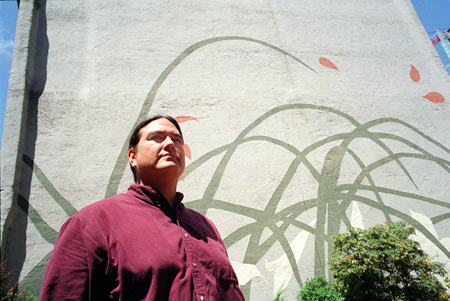SPH graduate will develop diabetes-intervention program for Native Americans

Donald Warne is about to make history, but he’s not happy about it.
After receiving his master’s degree from the School of Public Health, he will travel to Arizona to work with the National Institutes of Health (NIH) to develop a diabetes-intervention program for Native Americans in the Phoenix area.
He will be the first Native American to hold such a position.
Warne, a member of the Oglala Lakota tribe from the Pine Ridge reservation in South Dakota, believes it is about time someone with a Native American perspective took a look at this serious public health issue. He is glad to be chosen for that role, but hesitates to say that his appointment signals a change in the federal government’s treatment of Native Americans.
“It’s a sign that changes can occur,” he says, “Only time will tell if changes in attitude actually do occur.”
According to Warne, Native Americans in the Phoenix area have the highest incidence of diabetes in the United States. Many theories have been advanced to account for this situation, but Warne is convinced that the prevalence of the disease stems from the dramatic changes in diet and lifestyle that have affected the local Pima, Navajo, Apache, and Maricopa peoples.
In the days before Phoenix expanded to its present sprawling dimensions, Native Americans in the area lived primarily by farming; they ate a healthy diet of corn, squash, and beans, supplemented by fish and game.
Then, in the 1920s and ’30s, rivers were dammed, the city grew, and the Indians’ healthy lifestyle became a thing of the past. The U.S. Department of Agriculture’s Commodity Food Program stepped in to help, providing a diet of bleached flour, refined sugar, cheese, and canned meat. Over time, Native Americans became dependent on these handouts.
Warne knows that the solution to Indian health problems does not lie in going back to the past.
“You can’t go back to traditional farming unless you get rid of Phoenix,” he says.
But he does know that in order to be effective, any intervention program must take the Native American culture into account, and it must be holistic.
Warne is uniquely qualified to design and administer such a program. In addition to his M.P.H. degree, he earned an M.D. from Stanford Medical School in 1995, and he is also trained in acupuncture and homeopathy.
But perhaps most important of all, he comes from a family of traditional Lakota healers and is well-versed not only in herbal medicine but in the spiritual and emotional aspects of healing that characterize Native American concepts of health.
“In traditional Native American medicine there’s a balance between the spiritual, mental, physical, and emotional forces, but physicians deal only in the physical realm.”
Physicians, or practitioners of allopathic medicine, are primarily concerned with their patients’ blood-sugar levels and other purely physical aspects of diabetes. But there are other important components of the disease, Warne contends – anger, depression, stress, and spiritual issues.
“In modern medicine we don’t address such things. Blood sugar is important, but it doesn’t encompass the experience of diabetes. Allopathic medicine should be seen as one tool in a holistic approach.”
According to Warne, a major impediment to taking a holistic approach has been the Indian Health Service (IHS), a federal program for American Indians and Alaska Natives run by the U.S. Department of Health and Human Services. Wayne says the IHS is highly paternalistic and sees the local Native American culture as an obstacle rather than a resource.
The IHS, he points out, is not a welfare program, but was set up as a result of treaties entered into as early as the 18th century. The federal government agreed to provide housing, health care, and education in exchange for land. But the IHS is funded at only 40 percent of need.
“The federal government has not held up its end of the bargain,” Warne says, “I like to tell people, if you want to get rid of the IHS, fine. Just give us our land back.”
Although it is no longer possible to restore the ecological conditions under which native cultures in the Phoenix area once flourished, Warne believes that many health benefits can result from affirming and strengthening these cultures.
“Spiritual healing needs to occur,” he says. “It’s so important that local traditions, beliefs, and culture are incorporated into a prevention program.”
But he also knows that native cultures exist within the larger context of American society. It is for this reason that Warne has worked to become not only a medicine man but also a fully qualified man of medicine.
“I understand that to make effective change in the system you have to learn the language,” he says. “If you simply speak in terms of holism and spirituality, you will not be listened to. You have to back it up with credentials.”
What chance does Warne see for success in the incredibly challenging task he has mapped out for himself? To answer that question he quotes a fellow Lakota medicine man, the famous Black Elk (1863-1950).
Black Elk survived the massacre at Wounded Knee in 1890, in which U.S. cavalry murdered more than 350 Lakota, many of them women and children. As a result of that event, Black Elk said that the sacred hoop had been broken and that it would take seven generations to heal. Warne sees himself as contributing to the healing process.
“For people like me, the role is very simple,” he says. “We must facilitate healing. But we can only facilitate. We can’t control it or make it happen.”




